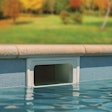
"The biggest trend I'm seeing on a residential level is minimizing carbon footprints and being more ecologically sound with just about every aspect of the project," says Mark Holden, owner of Holdenwater, a water architecture and engineering firm in Fullerton, Calif. "Our society is changing and the end-user is very aware."
Holden remembers a time early in his career when no such attention was paid to sustainable practices. But as the years have passed and Holden, a teacher at California Polytechnic State University, has seen new generations enter the field, he's observed an evolution away from the "gratuitous mindset of the '80s."
Higher Education
The "slash and burn mentality" is a classic example, says Holden. When someone wanted a new driveway back in the day, builders would jackhammer the existing driveway and toss it in a dumpster, where it would later be taken to a landfill. Nowadays, builders are taking those chunks of old driveway and are using them as stepping-stones, retaining walls or even patios.
Young landscape architects are leading the movement, Holden says.
When he teaches his construction class, he's surprised at how many questions he gets regarding permeable surfaces, how to complete underground cisterns so water can be kept on site and perked back into underground aquifers, how to reuse materials or use recycled materials on a project, and running pool pumps with solar panels.
In order to remain competitive with this new crop of landscape architects, Holden immerses himself in learning from every environment surrounding him, especially his students.
"It's this new generation of designers coming into the industry from various departments around the country. They are the ones who are going to change the industry.
"The echelon that is currently in place is going to lose popularity because they just don't have that skill set. My students have amazing skills at being able to perceive and manipulate and reuse materials."
Today's designs feature so many materials that are reused or recycled. Concrete plants are abundant, says Holden, so the possibility of having excess concrete ground up in to aggregate or even fresh concrete exists. Holden also says plant material gets reused or recycled, so builders can easily have trees that need to be removed turned in to bark or mulch or used as composting materials.
Growing From Here
Being surrounded by such a different mentality than the one he was taught has drastically changed Holden's style of design. He admits that his design and construction practices used to be "quite insensitive, uncaring to the ramifications." While he was focused on the site on an aesthetic level, there was no emotional connection on an environmental level.
As landscape design progresses with modern day demands, he's becoming more emotionally attached on an environmental level, and his designs show it. Where he once was a fan of the gratuitous use of waterfalls, he's taken it down a notch, and instead really focuses on the nuts and bolts of what it is a homeowner truly wants.
Holden cites a Seattle-based project where the homeowner wanted a 50-foot-wide waterfall that dropped 20,000 gallons of water per minute over the edge. He installed five 60-horsepower pumps just to turn over the water in the feature. While Holden says he'd be adamantly opposed to completing a project like this today, he did get the homeowners to tone down the project a bit, selling them on something that's subtle, appropriate and fitting for the location.
"What we do as designers is kind of like movie set design," says Holden. "You are creating an environment where you are making someone believe that they are not where they're at. You are creating a wonderful pool and waterfalls, and really you are in the backyard in the middle of the city.
"It's using environments and space to make someone feel a certain way. That's really all environmental design is, the manipulation of space to change someone's behavior or reaction. It's a neat concept."
Holden likens himself, and other landscape design/builders, to a therapist of sorts, in the sense that he guides clients toward what it is that will ultimately make them happy, while being mindful of their responsibility to the environment.
"Originally, when they say what their emotions are and what they think would make them happy, you get to kind of open their eyes to other environmentally sensitive ideas," says Holden. "Sometimes you can make them much happier about a project that they didn't spend as much money and didn't waste as many materials on. And they have a clear conscience, as well."
Lasting Impressions
Homogeneous projects used to fit the bill, notes Holden, simply because more opportunities to design existed. But these days, a family of four in a tract development can't spend $250,000 on their landscaping needs.
But while there is a lack of clientele, there are some people who are able to spend. And where those clients exist, so does the ideal to be better stewards of environment.
"Some people think an endless budget is an excuse for irresponsibility," says Holden. "I think the role of the professional is changing somewhat where you have to educate clients to feel guilty. It sounds strange, but it really is something that's not going to go away.
"This information and this mind-set of being ecologically sound and environmentally sensitive is now very systemic to our entire culture. And it's growing. It's something you want to pay attention to."
Comments or thoughts on this article? Please e-mail [email protected].











































